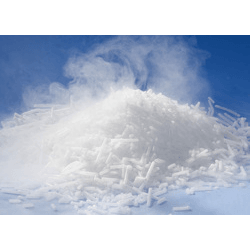Dry ICE Pellets Sales
he most common use of dry ice is to preserve food, using non-cyclic refrigeration.
It is frequently used to package items that must remain cold or frozen, such as ice cream or biological samples, without the use of mechanical cooling.
Dry ice can be used to flash-freeze food or laboratory biological samples, carbonate beverages, make ice cream, solidify oil spills and stop ice sculptures and ice walls from melting.

Dry ice can be used to arrest and prevent insect activity in closed containers of grains and grain products, as it displaces oxygen, but does not alter the taste or quality of foods. For the same reason, it can prevent or retard food oils and fats from becoming rancid.
Sublimation
Dry ice in water
When dry ice is placed in water, sublimation is accelerated, and low-sinking, dense clouds of smoke-like fog are created. This is used in fog machines, at theatres, haunted house attractions, and nightclubs for dramatic effects. Unlike most artificial fog machines, in which fog rises like smoke, fog from dry ice hovers near the ground.[13] Dry ice is useful in theatre productions that require dense fog effects.[20] The fog originates from the bulk water into which the dry ice is placed, and not from atmospheric water vapor (as is commonly assumed).
It is occasionally used to freeze and remove warts. However, liquid nitrogen performs better in this role, since it is colder so requires less time to act, and less pressure.Dry ice has fewer problems with storage, since it can be generated from compressed carbon dioxide gas as needed.
Plumbers use equipment that forces pressurised liquid CO2 into a jacket around a pipe. The dry ice formed causes the water to freeze, forming an ice plug, allowing them to perform repairs without turning off the water mains. This technique can be used on pipes up to 4 inches (100 mm) in diameter.
Dry ice can be used as bait to trap mosquitoes, bedbugs, and other insects, due to their attraction to carbon dioxide.
It can be used to exterminate rodents. This is done by dropping pellets into rodent tunnels in the ground and then sealing off the entrance, thus suffocating the animals as the dry ice sublimates.
Tiny dry ice pellets can be used to fight fire by both cooling fuel and suffocating the fire by excluding oxygen.
The extreme temperature of dry ice can cause viscoelastic materials to change to glass phase. Thus, it is useful for removing many types of pressure sensitive adhesives.
Industrial
Dry ice blasting used for cleaning a rubber mold
Dry ice blasting used for cleaning electrical installations
Dry ice can be used for loosening asphalt floor tiles or car sound deadening material making it easy to prise off, as well as freezing water in valveless pipes to enable repair.
One of the largest mechanical uses of dry ice is blast cleaning. Dry ice pellets are shot from a nozzle with compressed air, combining the power of the speed of the pellets with the action of the sublimation. This can remove residues from industrial equipment. Examples of materials removed include ink, glue, oil, paint, mold and rubber. Dry ice blasting can replace sandblasting, steam blasting, water blasting or solvent blasting. The primary environmental residue of dry ice blasting is the sublimed CO2, thus making it a useful technique where residues from other blasting techniques are undesirable.[30] Recently, blast cleaning has been introduced as a method of removing smoke damage from structures after fires.
Dry ice is also useful for the de-gassing of flammable vapours from storage tanks — the sublimation of dry ice pellets inside an emptied and vented tank causes an outrush of CO2 that carries with it the flammable vapours.
The removal and fitting of cylinder liners in large engines requires the use of dry ice to chill and thus shrink the liner so that it freely slides into the engine block. When the liner then warms up, it expands, and the resulting interference fit holds it tightly in place. Similar procedures may be used in fabricating mechanical assemblies with a high resultant strength, replacing the need for pins, keys or welds.
Dry-ice blasting, a form of carbon dioxide cleaning, is used in a number of industrial applications.
It is also useful as a cutting fluid.
Scientific
In laboratories, a slurry of dry ice in an organic solvent is a useful freezing mixture for cold chemical reactions and for condensing solvents in rotary evaporators.[33] Dry ice and acetone forms a cold bath of −78 °C (−108 °F; 195 K), which can be used for instance to prevent thermal runaway in a Swern oxidation.
The process of altering cloud precipitation can be done with the use of dry ice.[34] It was widely used in experiments in the US in the 1950s and early 1960s before it was replaced by silver iodide.[34] Dry ice has the advantage of being relatively cheap and completely non-toxic.[34] Its main drawback is the need to be delivered directly into the supercooled region of clouds being seeded.[34]
OUR TESTIMONIALS

Allied has provided equipment and consulting support on many of our large commercial projects for hotel clients in San Francisco .
- Tim M

We have relied on allied countless times to tackle the toughest tasks.
Great resource.
- Adam R

Allied supplies us with equipment and support on all of our major disaster recovery endeavors and projects.
- Marcello
